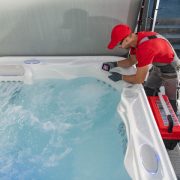
Embracing Elegance and Efficiency: The Ultimate Guide to Choosing the Perfect Spa Cover
A spa is an oasis of relaxation in your home. But to keep its waters pure, warm, and free from debris, a proper spa cover is non-negotiable. Yet, with the variety available, how do you choose the right one? Dive in as we explore the different types of spa covers and the upsides and downsides of each.
1. Traditional Hard Spa Covers:
Pros:
- Durability: Made of sturdy materials like vinyl, these can withstand heavy weights, making them resistant to pets, children, or falling debris.
- Energy Efficiency: Its insulating foam core retains heat, cutting down energy bills.
- Security: Many come with locking straps, deterring unwanted access.
Cons:
- Bulkiness: Can be heavy and might require two people or a cover lifter to move.
- Wear and Tear: Vinyl can get brittle or faded with prolonged sun exposure.
2. Soft Spa Covers:
Pros:
- Lightweight: Easier to maneuver and store.
- Cost-Effective: Generally cheaper than hard covers.
- Versatility: Suitable for irregularly shaped spas.
Cons:
- Limited Durability: Not as long-lasting as hard covers.
- Reduced Insulation: Less efficient in retaining heat, leading to increased energy costs.
3. Rolling Spa Covers:
Pros:
- Easy Access: Rolls on and off effortlessly, ideal for solo spa-goers.
- Good Insulation: Combines the benefits of hard and soft covers.
Cons:
- Space Consumption: Requires space at one end of the spa for storage when rolled up.
- Aesthetic Limitations: Might not be as visually appealing as other options.
4. Seasonal Spa Covers:
Pros:
- Weather Resistant: Specifically designed to tackle seasonal extremes.
- Enhanced Durability: Crafted to withstand the rigors of harsh climates.
Cons:
- Limited Versatility: Primarily suitable only for the specific season it’s designed for.
5. Automated Spa Covers:
Pros:
- Convenience: Opens and closes with the push of a button.
- Space-Saving: Doesn’t require manual storage space.
Cons:
- Pricey: Significantly more expensive than manual covers.
- Maintenance Needs: Mechanical components might require periodic servicing.
Factors to Consider When Choosing:
- Climate: Areas with heavy snowfall might require a sturdier cover.
- Usage Frequency: If you use your spa often, opt for an easily removable cover.
- Budget: Determine what you’re willing to spend and find a cover that offers the best value within that range.
- Aesthetics: Ensure the cover complements your spa’s look and surrounding decor.
- Safety: If you have kids or pets, ensure the cover has secure locking mechanisms.
Conclusion:
Selecting the right spa cover is as much an art as it is a science. It’s about marrying functionality with aesthetics while ensuring longevity and value for money. Remember, a spa cover isn’t just about protection; it’s an investment in many tranquil and hassle-free spa experiences to come. So, take a moment, weigh the options, and make a choice that ensures every dip is a delight!

